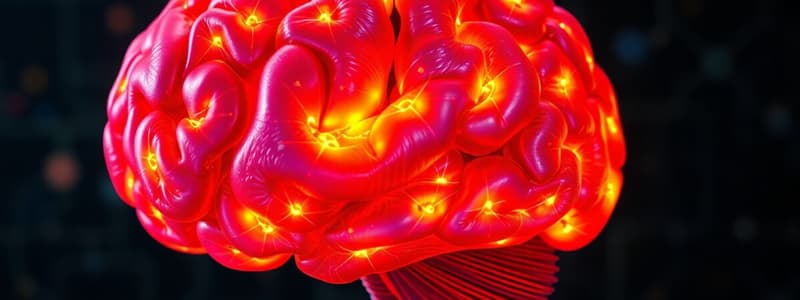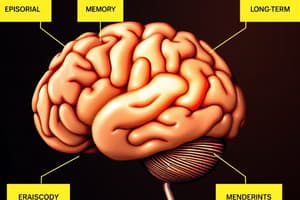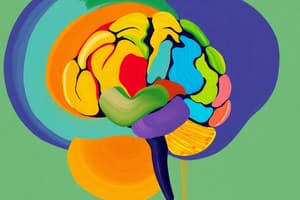Podcast
Questions and Answers
Which of the following is an example of explicit long-term memory?
Which of the following is an example of explicit long-term memory?
- Skill learning, such as riding a bicycle.
- Priming, where exposure to one stimulus influences a response to a subsequent stimulus.
- Semantic memory, involving facts and general knowledge. (correct)
- Conditioning, like associating a bell with food.
What distinguishes a double dissociation from a single dissociation in the study of memory?
What distinguishes a double dissociation from a single dissociation in the study of memory?
- A double dissociation only applies to short-term memory, whereas a single dissociation applies to long-term memory.
- A double dissociation involves impairment in only one task, while a single dissociation affects all tasks.
- A double dissociation relies on subjective data, while a single dissociation uses objective measures.
- A double dissociation demonstrates that two cognitive processes are completely independent with separate mechanisms, whereas a single dissociation doesn't necessarily prove this. (correct)
Which of the following best describes the encoding process in long-term memory?
Which of the following best describes the encoding process in long-term memory?
- The reorganization and restabilization of memory traces after retrieval.
- The initial creation of memory traces in the brain from incoming information. (correct)
- The retrieval of stored information when needed.
- The maintenance of memory traces over time.
In the context of implicit memory, what is non-associative learning?
In the context of implicit memory, what is non-associative learning?
Which of the following best describes the role of consolidation in long-term memory?
Which of the following best describes the role of consolidation in long-term memory?
What is the primary difference between declarative and non-declarative memory?
What is the primary difference between declarative and non-declarative memory?
In the context of memory, what does 'priming' refer to?
In the context of memory, what does 'priming' refer to?
How does sensitization differ from habituation in non-associative learning?
How does sensitization differ from habituation in non-associative learning?
Which brain structure is most closely associated with classical conditioning, particularly in emotional responses like fear?
Which brain structure is most closely associated with classical conditioning, particularly in emotional responses like fear?
Why is the study of patients with specific brain lesions important in understanding memory systems?
Why is the study of patients with specific brain lesions important in understanding memory systems?
What is the role of prediction error in motor skill learning?
What is the role of prediction error in motor skill learning?
Which of the following is an example of procedural memory?
Which of the following is an example of procedural memory?
What neural change underlies long-term sensitization?
What neural change underlies long-term sensitization?
Which of the following scenarios best illustrates classical conditioning?
Which of the following scenarios best illustrates classical conditioning?
What distinguishes short-term memory from long-term memory in terms of capacity and duration?
What distinguishes short-term memory from long-term memory in terms of capacity and duration?
Which process is associated with the neural changes that occur during motor adaptation?
Which process is associated with the neural changes that occur during motor adaptation?
What is the key feature of motor sequence learning that distinguishes it from motor adaptation?
What is the key feature of motor sequence learning that distinguishes it from motor adaptation?
What is the role of dopamine in reinforcement learning?
What is the role of dopamine in reinforcement learning?
How does damage to the left temporoparietal cortex, as seen in Patient K.F., typically manifest in memory performance?
How does damage to the left temporoparietal cortex, as seen in Patient K.F., typically manifest in memory performance?
Why can a single dissociation be a 'dangerous' conclusion when studying separate memory systems?
Why can a single dissociation be a 'dangerous' conclusion when studying separate memory systems?
What is the difference between the neural basis of short-term and long-term memory?
What is the difference between the neural basis of short-term and long-term memory?
Which of the following is NOT a type of implicit long-term memory?
Which of the following is NOT a type of implicit long-term memory?
If a patient shows impaired word recognition but intact perceptual identification, which type of memory is likely impaired?
If a patient shows impaired word recognition but intact perceptual identification, which type of memory is likely impaired?
What is the main difference between habituation and sensitization?
What is the main difference between habituation and sensitization?
Which brain region is directly involved in classical conditioning for fear responses?
Which brain region is directly involved in classical conditioning for fear responses?
Flashcards
Problem of Memory
Problem of Memory
Acquiring information from experience, maintaining it over time, and using it to guide behavior and plan future actions.
Encoding
Encoding
Initial creation of memory traces in the brain from incoming information
Consolidation
Consolidation
Continued organization and stabilization of memory traces over time
Storage
Storage
Signup and view all the flashcards
Retrieval
Retrieval
Signup and view all the flashcards
Reconsolidation
Reconsolidation
Signup and view all the flashcards
Explicit Memory
Explicit Memory
Signup and view all the flashcards
Implicit Memory
Implicit Memory
Signup and view all the flashcards
Episodic Memory
Episodic Memory
Signup and view all the flashcards
Semantic Memory
Semantic Memory
Signup and view all the flashcards
Procedural Memory
Procedural Memory
Signup and view all the flashcards
Non-associative Learning
Non-associative Learning
Signup and view all the flashcards
Habituation
Habituation
Signup and view all the flashcards
Sensitization
Sensitization
Signup and view all the flashcards
Classical Conditioning
Classical Conditioning
Signup and view all the flashcards
Conditioned Stimulus (CS)
Conditioned Stimulus (CS)
Signup and view all the flashcards
Unconditioned Response (UR)
Unconditioned Response (UR)
Signup and view all the flashcards
Double Dissociation
Double Dissociation
Signup and view all the flashcards
Motor Adaptation
Motor Adaptation
Signup and view all the flashcards
Forward Model
Forward Model
Signup and view all the flashcards
Motor Sequence Learning
Motor Sequence Learning
Signup and view all the flashcards
Prediction Error
Prediction Error
Signup and view all the flashcards
Compensation Argument
Compensation Argument
Signup and view all the flashcards
Importance of memory
Importance of memory
Signup and view all the flashcards
Study Notes
- Long-term memory is the main focus, with assigned reading from Ch. 9 and Lab 6 due March 21, instructed by Dr. Mugon at the University of Victoria, Spring 2025.
The Definition of Memory
- Memory encompasses processes, types, systems, and tasks, studied through methods like lesions and double dissociation.
- Short-term and long-term memory are distinct categories.
- Memory can be implicit or explicit.
Implicit Long-Term Memory
- This includes non-associative learning, conditioning, skill learning, and priming.
Explicit Long-Term Memory
- Semantic and Episodic memory fall under this category along with consolidation and reconsolidation.
- Learning is closely related to memory.
- Memory employs encoding, storage, retrieval, and potentially reconsolidation to maintain information.
- Memory involves multiple processes, including encoding, storage, and retrieval.
- Memory also contains semantic, episodic, and procedural types.
- Systems include the hippocampus, cortex, and amygdala.
- Tasks involve free recall, stem completion, and motor sequence learning.
- Memory requires physical changes in the nervous system and is pervasive within it.
Memory and Time
- Encoding is the initial step where incoming information creates memory traces in the brain.
- Consolidation involves the continued organization and stabilization of these memory traces over time.
- Storage is the retention of memory traces over time.
- Retrieval is the process of accessing or using stored information from memory traces.
- Reconsolidation may involve the reorganization and restabilization of memory traces after retrieval.
LTM Types & Systems
- Long-term memory splits into Declarative memory (explicit) and Nondeclarative memory (implicit).
- Declarative memory encompasses event or episodic memory and facts or semantic memory.
- Nondeclarative memory has procedural memory, perceptual representation, classical conditioning and nonassociative learning
Dissociating Short-Term & Long-Term Memory
- The question posed is whether STM and LTM are separate systems.
- Dissociation logic suggests separate systems if performance differs across tasks.
- Single dissociation occurs if one function is impaired while the other is spared, however this does not necessarily mean they are separate systems.
- Double dissociation, where two patterns are flipped, indicates stronger evidence for separate systems relying on different brain mechanisms.
Memory Task Examples
- Standard Short-term memory task involves hearing and immediately recalling a sequence of three words.
- A Standard Long-term memory task involves hearing a list of ten words and immediately recalling them in any order, repeating until all are recalled.
Patient Studies
- Patient K.F. with damage to the left temporoparietal cortex, exhibits single dissociation.
- Short-term memory tasks rely on the temporoparietal junction, which long-term memory tasks do not.
- Alternative explanations include the possibility of a single system damaged to varying degrees or compensation in one task due to damage.
- Patient H.M., with damage to bilateral medial temporal lobes, shows different dissociation patterns compared to K.F.
- Double dissociation, consisting of two areas of damage and two opposing single dissociations, is strong evidence that short-term and long-term memory are separable systems
Short-term vs. Long-term memory
- Short-term memory has timescales of seconds, limited capacity, and depends on sustained neuron activation.
- Long-term memory operates on timescales from minutes to years, possesses massive capacity, and relies on the number and strength of synapses.
- Explicit memory involves conscious recall, while implicit memory does not.
Dissociating Implicit & Explicit LTM
- An implicit memory task involves perceptual identification, where subjects are briefly shown words after a prior study phase.
- An explicit memory task involves word recognition, where subjects respond "yes" or "no" to indicate if words were from a prior study phase.
Patients with Impaired Memory
- Patient M.S., with damage to the right occipital lobe, shows impaired implicit memory (priming) but intact explicit memory (word recognition).
- Amnesia patients, such as those with Korsakoff’s syndrome or epilepsy, show impaired explicit memory (word recognition) but larger than normal priming effects in implicit memory.
- Double dissociation between cognitive and brain systems involved in perceptual identification and word recognition are evidence that systems are distinct.
Types of Long-Term Memory
- Implicit long-term memory is non-declarative, independent of conscious awareness and can include procedural memory, conditioning, non-associative learning, or priming.
- Explicit long-term memory is declarative, available to conscious awareness, and can be semantic or episodic.
- Implicit memory has a timescale of minutes, hours, days, years and capacity for thousands of motor skill sequences
- Explicit memory has a timescale of minutes, hours, days, years and capacity potentially 20,000 word families Both rely on the number and strength of synapses for neural basis.
Implicit Memory: Non-Associative Learning
- Non-associative memory results from a change in response to a single stimulus after repeated exposure.
- Habituation is a reduced response to a repeated stimulus, such as no longer noticing a clock's ticking.
- Sensitization is an increased response to a repeated stimulus.
- Non-associative learning involves sensory-motor reflex pathways.
Neural Basis of Non-Associative Memory
- First evidence was done by Eric Kandel by studying sea slug Aplysia.
- Habituation process where presynaptic depression occurs, the action potential remains the same but neurotransmitter release is reduced, causing a smaller EPSP.
- Sensitization process involves presynaptic facilitation, where the action potential remains same but increased neurotransmitter release and larger EPSP.
- "Short-term" changes in habituation/sensitization last minutes and is due to changes in neurotransmitter release
- "Long-term" changes in habituation/sensitization last hours, days, or weeks and is due to changes in synapse numbers
Classical Conditioning
- Pavlov noticed that a dog learned to salivate in response to a bell that predicted food.
- Unconditioned stimulus (US) is food.
- Unconditional response (UR) is salivation.
- Neutral stimulus (NS) is a bell before pairing.
- Conditioned stimulus (CS) is the bell after pairing.
- Conditioned response (CR) is salivation after pairing.
- US causes UR and paired CS causes CR
- Fear conditioning causes freezing
Fear Conditioning
- US is shock in fear conditioning
- UR, CS and CR is all freezing
- CS and US converge in lateral nucleus of amygdala
Motor skill learning
- Motor skill learning is motor system dependent.
- Motor adaptation relies on cerebellar loops.
- Motor sequence learning involves cortico-basal ganglia-thalamocortical loops.
- Cerebellum uses a forward model to predict the results of motor commands.
- Uses differences between actual results and what you predicted for: online error correction, motor learning and feedback.
Skill Learning: Motor Sequence Learning
- Serial reaction time (SRT) task involves responding to a sequence of lights, with repetition leading to faster response times without conscious awareness.
- Serial reaction time (SRT) depends on basal ganglia thalamo cortical loops
- Depends on basal ganglia and reinforcement learning for action performance, comparing predicted and actual rewards to update expectations.
- Dopamine signals prediction error, with larger responses for better outcomes and smaller for worse.
- Reinforcement learning is where unexpected rewards generate dopamine signals from the substantia nigra, exciting the direct pathway. Dopamine allows modification of behavior based on reward.
Studying That Suits You
Use AI to generate personalized quizzes and flashcards to suit your learning preferences.




